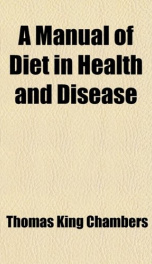a manual of diet in health and disease

Purchase of this book includes free trial access to www.million-books.com where you can read more than a million books for free. Excerpt from book: Section 3CHAPTER II. ON THE CHOICE OF FOOD. There is no rule capable of such universal application as that all articles designed for human food should be the best of their kind which can be procured, and that it is false economy to be tempted by a lower price to be satisfied with less eligible wares. The saving in money is always out-balanced by the inferior utility. Economy, when necessary, should be practised in quantity, not quality, in the sort of food chosen, and not in its degree of perfection. As to the arrangement of the subject, the naturalist's classification has been that usually adopted by authors. But it seems to me less scientifically appropriate to the matter in hand, and more likely to involve repetition, than one which brings together articles associated in the market, and which, indeed, often combine elements derived from several realms of nature. These articles are here to be considered solely as food for man, and not as independent members in creation. § 1. Butcher's Meat. The lean of butcher's meat should show a deep purplish red tint, with a sort of bloom over it, on the outside of the muscle, and a lighter vermilion red with a bare shade of purple in the cut surface. The lean of beef may be a.little marbled with fat, but that of mutton should be quite even in hue. When cut in a very fine slice, or stretched in a thin layer over C the fat, as naturally, in the ribs, it is semi-transparent and orange-vermilion in uniform streaks.1 The surface is quite dry, and even the cut should scarce wet the finger. In substance it is moderately soft, but extremely elastic, so that no mark is left after pressure. A day or two in the larder should make no difference in this respect. There is very little odour in a single joint of good meat, and what there is, to most people, is not u...
Info about the book
Author:
Series:
Unknown
ISBN:
1451640714
Rating:
3.5/5 (1)Your rating:
0/5
Languge:
English
Users who have this book
Users who want this book
What readers are saying
What do you think? Write your own comment on this book!
write a commentif you like a manual of diet in health and disease try:
Do you want to read a book that interests you? It’s EASY!
Create an account and send a request for reading to other users on the Webpage of the book!



